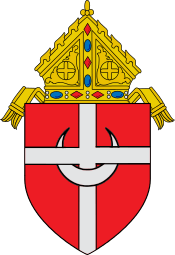Richard Charles Patrick Hanifen
Richard Charles Patrick Hanifen (born June 15, 1931) is an American prelate of the Roman Catholic Church. He was the first Bishop of Colorado Springs, serving from 1984 to 2003. He previously served as an auxiliary bishop of the Archdiocese of Denver (1974–84).
Early life and education
Hanifen was born in Denver, Colorado, the third of four children of Edward Anselm and Dorothy Elizabeth (née Ranous) Hanifen.[1] His grandfather immigrated from Canada to Leadville during the 1880s silver boom, and eventually became a successful mine owner; Hanifen's father co-founded a prominent Colorado investment firm.[1] As a child, Hanifen suffered from chronic asthma.[2] He received his early education at the parochial school of St. Philomena Church, where he occasionally served as an altar boy.[2] He attended Regis High School while working as a delivery boy for a grocery store.[2]
After graduating from high school in 1949, Hanifen enrolled at Regis College in Denver.[2] He earned a Bachelor of Science degree in accounting from Regis in 1953.[2] He then began his studies for the priesthood at St. Thomas Aquinas Seminary in Denver.[1] During his studies, he and fellow seminarian Eugene John Gerber were selected to participate in an experimental pairing between St. Thomas and the Catholic University of America in Washington, D.C.[2] He later earned a Bachelor of Sacred Theology degree from Catholic University in 1959.[2]
Priesthood
On June 6, 1959, Hanifen was ordained a priest by Archbishop Urban J. Vehr at the Cathedral of the Immaculate Conception.[3] His first assignment was as an assistant pastor at Our Lady of the Mountains Church in Estes Park.[1] He then served at the Cathedral of the Immaculate Conception until 1966, when he was sent to further his studies at Catholic University.[1] He there earned a Master of Arts degree in guidance and counseling in 1966.[1]
In 1968, Hanifen earned a Licentiate of Canon Law from the Pontifical Lateran University in Rome.[1] During his time in Rome, he and some of his fellow students took a trip to Florence, during which they experienced the devastating flood of the River Arno.[2] Following his return to Denver, he served as vice-chancellor of the archdiocese and secretary to Archbishop James V. Casey from 1968 to 1969.[2] From 1969 to 1976, he served as chancellor of the archdiocese.[2]
Episcopacy
Denver
On July 6, 1974, Hanifen was appointed Auxiliary Bishop of Denver and Titular Bishop of Abercornia by Pope Paul VI.[3] He received his episcopal consecration on the following September 20 from Archbishop Casey, with Bishops George R. Evans and Charles A. Buswell serving as co-consecrators.[3] As an auxiliary bishop, he served as episcopal vicar for the southern area of the archdiocese from 1975 to 1984.[2]
Hanifen was in Rome for a one-month study sabbatical when Pope John Paul I was elected in the papal conclave of August 1978; he later participated in the new pope's Inauguration Mass on September 3 of that year.[2]
Colorado Springs
On November 10, 1983, Hanifen was appointed the first Bishop of the newly erected Diocese of Colorado Springs by Pope John Paul II.[3] The new diocese encompassed 15,560 square miles (40,300 km2), being composed of Chaffee, Cheyenne, Douglas, Elbert, El Paso, Kit Carson, Lake, Lincoln, Park, and Teller Counties.[1] With a Catholic population of approximately 65,000, the diocese also contained twenty-four parishes, ten missions, fifty priests, 230 sisters, five grade schools, and one high school.[1] Hanifen was installed at the Pikes Peak Center on January 30, 1984.[3] Of his vision for his ministry as bishop, he told The Colorado Springs Gazette in January 1984, "A bishop should not be a glaring watch dog of orthodoxy but a good shepherd of his flock."[1]
Among his first acts as bishop, Hanifen selected St. Mary's Church as the cathedral of the diocese, and launched The Catholic Herald, the monthly diocesan newspaper, in September 1984.[1] He emphasized collaboration with the laity, appointing them to leadership positions within the diocese to ease the burden of the clergy.[2] He also supported ecumenism and interfaith dialogue, even co-founding the Center for Christian-Jewish Dialogue with Rabbi Howard Hirsch.[2] During Hanifen's nearly two decades as the helm of the diocese, the number of Catholics and parishes nearly doubled.[2]
Later life
After 19 years as Bishop of Colorado Springs, Hanifen resigned on January 30, 2003.[3] He was succeeded by Bishop Michael John Sheridan, an auxiliary bishop of the Archdiocese of St. Louis, Missouri.[4]
References
- 1 2 3 4 5 6 7 8 9 10 11 Noel, Thomas J. "Casey: The Gentle Shepherd (1967-1986)". Colorado Catholicism: The Archdiocese of Denver (1857-1989).
- 1 2 3 4 5 6 7 8 9 10 11 12 13 14 15 "A Brief Biography of Bishop Hanifen" (PDF). The Colorado Catholic Herald. 2009-06-05.
- 1 2 3 4 5 6 "Bishop Richard Charles Patrick Hanifen". Catholic-Hierarchy.org.
- ↑ "Most Rev. Michael J. Sheridan, S.T.D.". Roman Catholic Diocese of Colorado Springs. Archived from the original on September 18, 2007.
| Catholic Church titles | ||
|---|---|---|
| Preceded by none |
Bishop of Colorado Springs 1984—2003 |
Succeeded by Michael John Sheridan |

